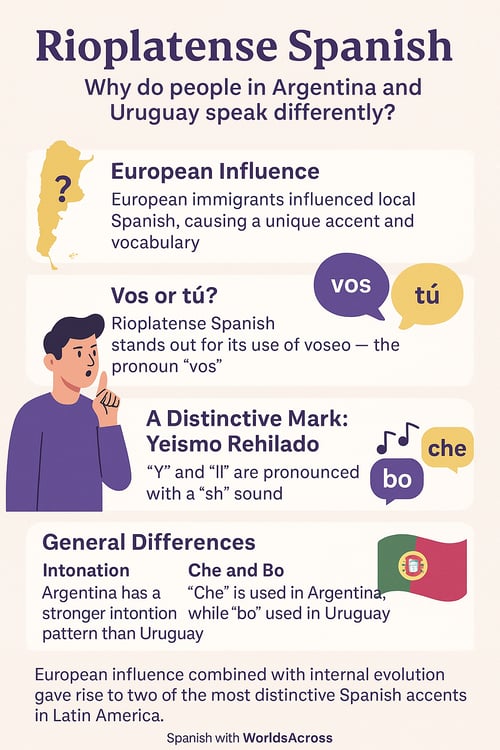Why do they speak differently in Argentina and Uruguay?

When we think about Spanish being the official language in more than 20 countries, it makes sense that many different accents have emerged throughout history. From the sensual Colombian accent to the confusing but fascinating way Chileans speak, each accent is unique and reflects the essence of the country that adopted it. However, there are two countries whose accents stand out significantly from the rest. ¿Sha sabés cuáles son?? That’s right! Argentina and Uruguay.
Keep reading — we’ll now explore the linguistic heritage of these two major examples of Spanish pronunciation.
European Influence
To understand why Argentina and Uruguay stand out for their uniqueness within Latin American Spanish, it’s essential to mention the influence of European immigrants. In the late 19th century, these two countries experienced a significant wave of immigration. Millions of Europeans, especially Italians, arrived in search of new and better opportunities.
This phenomenon caused the local Spanish to mix with their languages and dialects, resulting in a unique and peculiar accent and vocabulary.
Vos or tú?
When it comes to Spanish pronunciation, Rioplatense Spanish stands out effortlessly. One of its most distinctive features is the use of voseo, a form of address that replaces “tú” with “vos.” This famous voseo comes from medieval Spanish and was mainly used to address people of higher social status with respect.
Over time, Spanish-speaking countries dropped voseo in favor of other forms of courtesy, such as “usted.” However, Argentina and Uruguay were the exception — both countries preserved and evolved voseo, making it one of the most iconic features of Rioplatense Spanish. What a way to stand out!
A Distinctive Mark: Yeísmo Rehilado
¿Lluvia o shuvia? ¿Yate or shate? We can’t talk about the unique pronunciation in these countries without mentioning how they pronounce the letters “y” and “ll.” In Argentina and Uruguay, both letters are pronounced with a sound similar to the English “sh.” For example, the word calle (street) would be pronounced ca-ye in other Spanish-speaking countries; however, Argentinians and Uruguayans would say ca-she.

General Differences
We’ve mentioned how Spanish pronunciation and accent in these two countries have changed how the language is experienced in Latin America. Even while acknowledging the similarities, we might ask: Are there any differences between them? Of course! Here are a few:
-
Intonation
Although the intonation in both countries is quite similar, Argentina is known for a rising and falling rhythm in its phrases, creating a very distinctive melody. In contrast, Uruguay’s intonation is not as pronounced; in some regions, it’s considerably softer and more neutral than in Argentina.
-
Che and Bo
In Argentina, che is used to get someone’s attention or address someone informally. While Uruguayans also use che, they have their own word: Bo! In this way, bo in Uruguay is pretty much the same as che in Argentina.
¡Che, no te lo puedo creer! ¡Bo! Te juro que es verdad.
-
Differences in Yeísmo
Although yeísmo — also known as sheísmo — is present in both countries, its use is much more widespread in Argentina. In fact, there are regions in Uruguay where people pronounce the letters “ll” and “y” just like the rest of the Spanish-speaking world.
-
Portuguese Influence
In Uruguay, thanks to its proximity to Brazil, a dialect influenced by Portuguese known as Portuñol has developed. This interesting blend of Spanish and Portuguese is practically nonexistent in Argentina.
Ultimately, we can conclude that the differences between the Spanish of Argentina and Uruguay compared to other Spanish-speaking countries are largely due to the European influence these countries experienced. This influence, combined with internal evolution of the language, gave rise to two of the most distinctive Spanish accents in Latin America.
The fact that pronunciation and accent in these two countries differ so much from the rest of the Spanish-speaking world not only allows us to appreciate the fascinating diversity of Spanish — it also shows us how historical and cultural experiences shape and breathe life into language.
“Bueno, che, me voy yendo.
¡Nos vemos mañana!”
“Dale, bo, que pases bien.
¡Nos hablamos!”



